Engaging with potted plant arrangement ideas transforms blank corners into living works of art, blending color, texture, and height for spaces that breathe life and personality. Having spent years experimenting with hundreds of plant combos on balconies and patios, I’ve learned which pairings thrive and how design principles like balance, contrast, and scale can be applied even in the smallest pots. Whether you want low-maintenance greenery or a vibrant floral show, each potted plant arrangement idea here reflects practical advice backed by real-world trials. Prepare to discover techniques that bring out the best in every plant and turn ordinary containers into stunning focal points that spark joy and calm alike.
1. Use Gorgeous Foliage to Elevate Your Potted Plant Arrangement
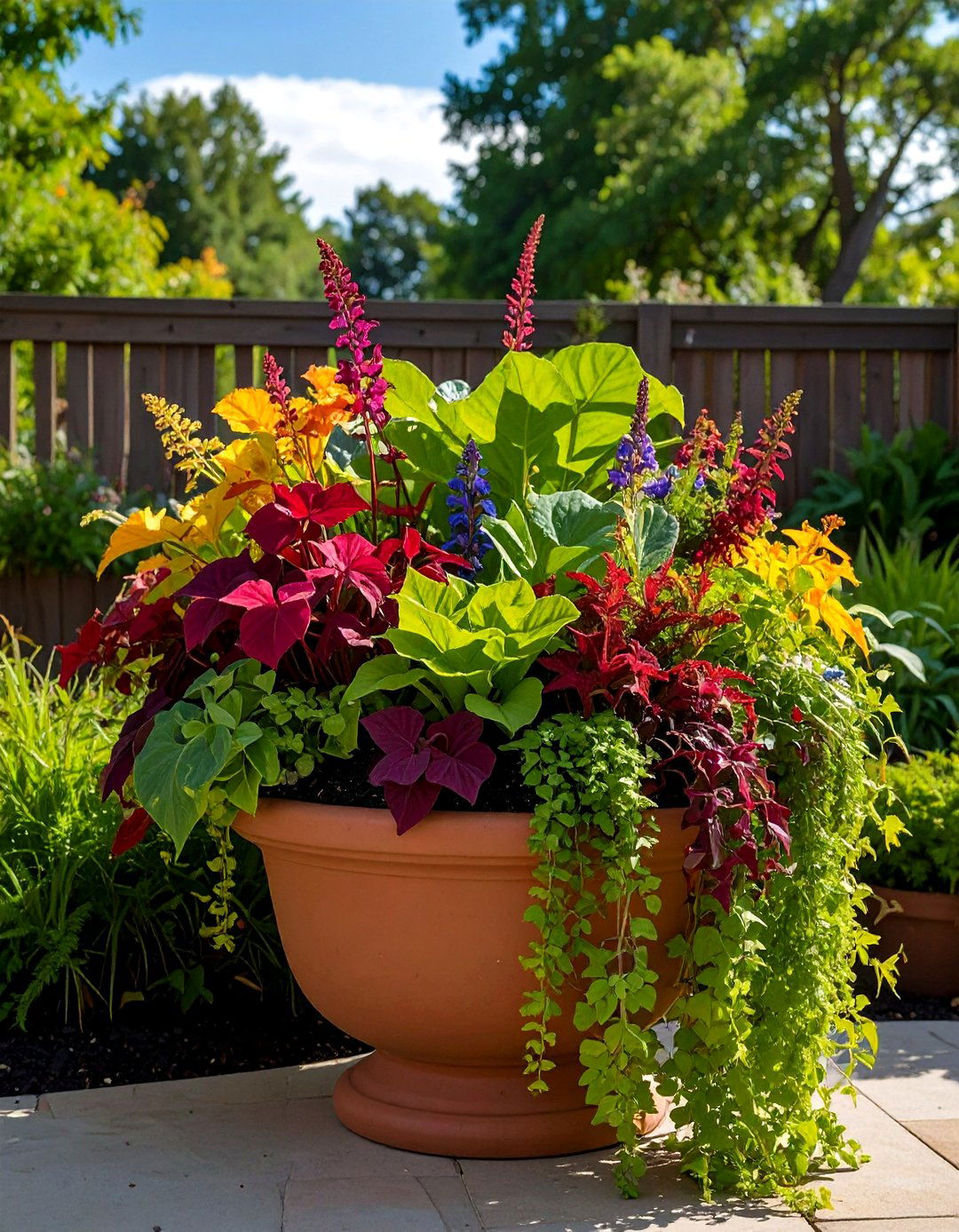
Gorgeous foliage can be the star of any potted plant arrangement, bringing bold shapes and rich hues that last beyond flowering season. In a foliage-forward plant arrangement, choose statement-making leaves like velvety Acalypha or sculptural elephant ear as your thriller at the back, then complement with mounding coleus and trailing sweet potato vine as spillers. This combination creates depth through contrasting textures and dramatic color without relying on blooms alone. To start, select pots with good drainage and pair foliage plants with similar light and watering needs for consistency. Rotate containers occasionally to balance sun exposure, ensuring vibrant leaves on all sides. By centering foliage, your potted plant arrangement will remain eye-catching throughout the season.
2. Create a Summertime Gem with Vibrant Potted Plant Arrangements
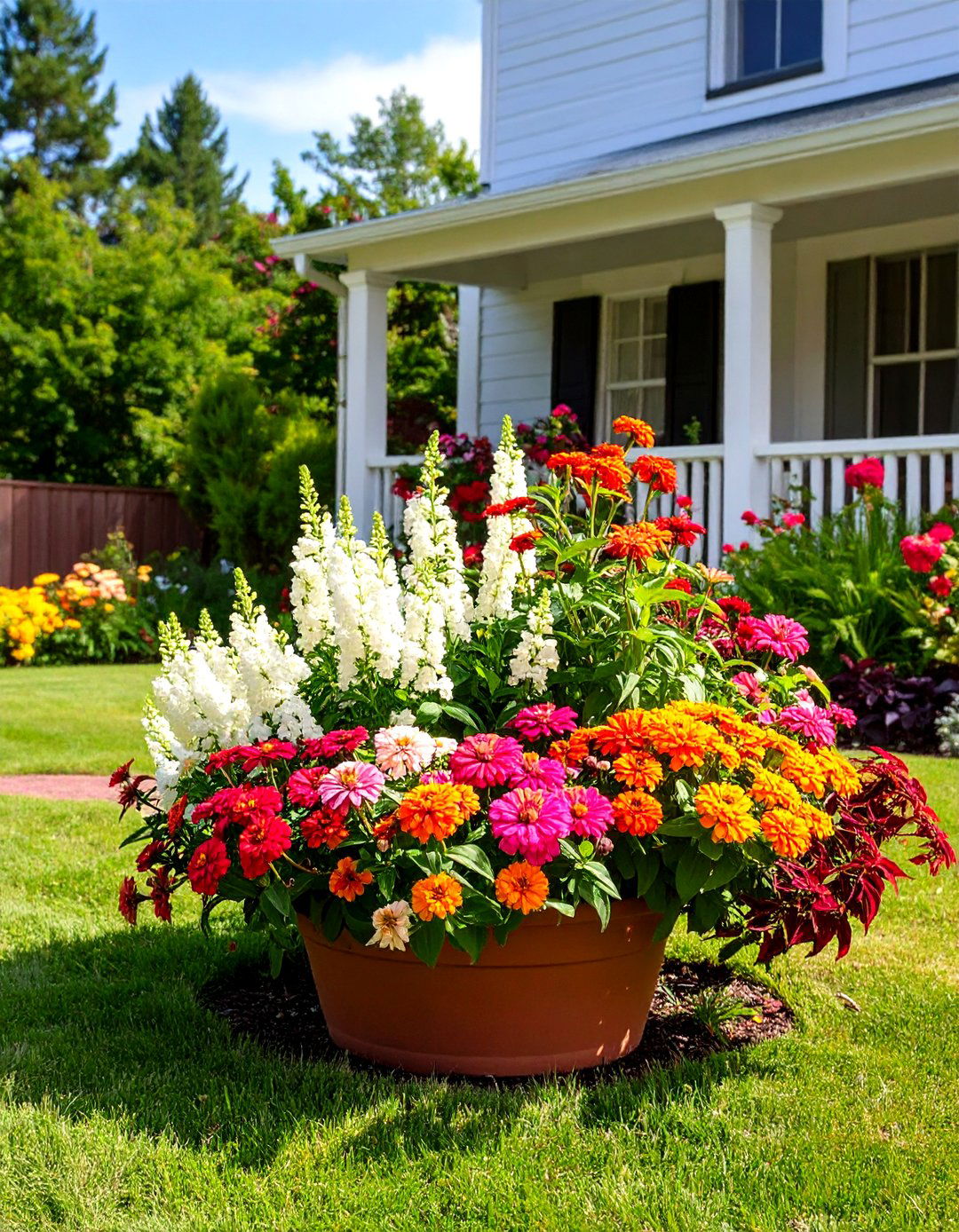
Capturing the joy of high summer, a summertime gem potted plant arrangement uses hardy blooms like white angelonia as tall thrillers, vibrant Profusion zinnias as mound-forming fillers, and variegated coleus as cascading spillers. This classic pairing ensures months of color while requiring minimal care, perfect for busy plant enthusiasts. Begin by selecting a sturdy container with rich potting mix, placing the angelonia at the center or back to frame the pot. Add zinnias around the middle for pops of orange or pink, then edge the space with cascading coleus for volume. Deadhead faded flowers regularly and feed lightly every two weeks to prolong the bloom cycle. With these steps, your potted plant arrangement becomes a summer standout.
3. Employ a Cohesive Color Scheme in Your Potted Plant Arrangement
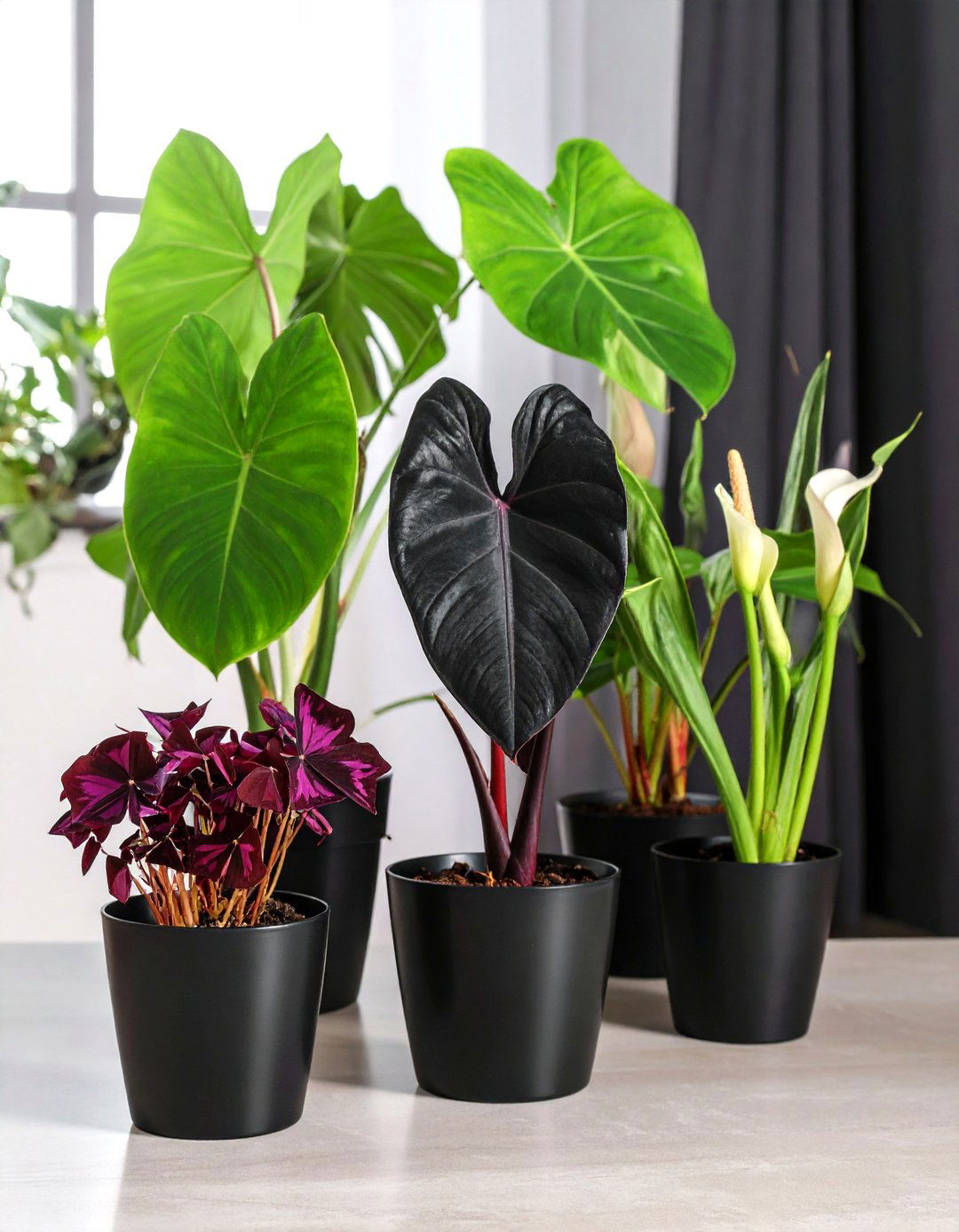
Using a focused color scheme turns any potted plant arrangement into a polished display, especially when you limit your palette to one or two complementary hues. For instance, a turquoise planter filled with deep blue angelonia, purple flamingo celosia, and soft blue calibrachoa creates a harmonious look that feels curated. To replicate this effect, select a container that echoes your primary color and choose plant varieties in matching or accent shades. Space them evenly and allow each bloom to shine without overcrowding. Regular pruning helps maintain the bold color contrast. By intentionally coordinating plant and pot hues, your potted plant arrangement will appear both sophisticated and unified, elevating any porch or patio space.
4. Go Classic with Black Containers for Potted Plant Arrangements
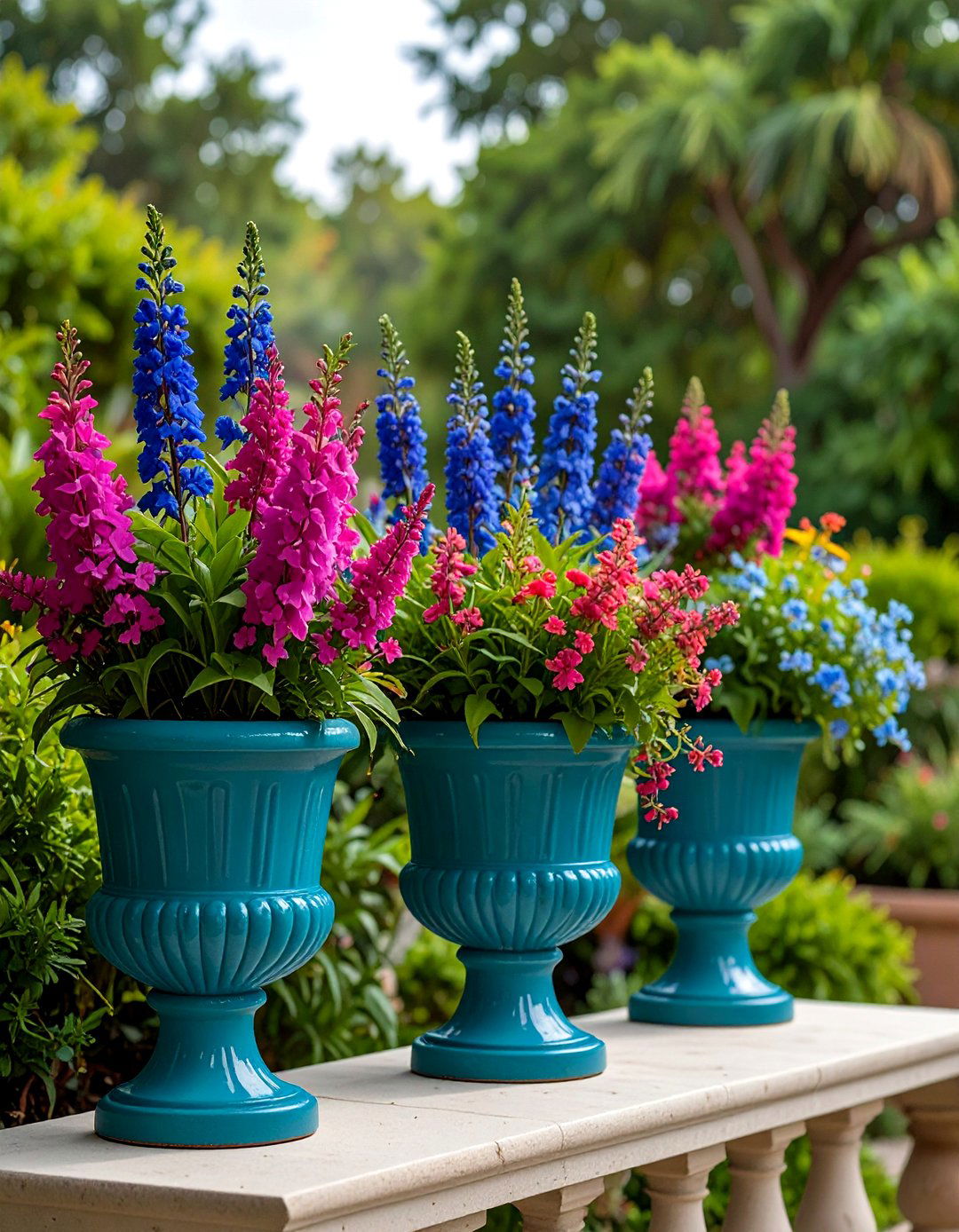
A sleek black pot provides the perfect backdrop for a dramatic potted plant arrangement, allowing bright blooms and foliage to really pop. Begin with a black-glazed container, then choose oxalis varieties with deep purple leaves and candy cane oxalis for a festive twist. Add a single black calla lily or a sculptural elephant ear to anchor the design and offer height. The high-contrast pairing of black pottery against vibrant greens and whites draws the eye, making the arrangement a showstopper. To ensure healthy growth, line the pot with gravel for good drainage and use a rich, aerated potting mix. This classic black theme brings a modern edge to any plant arrangement.
5. Mix It Up: Diverse Blooms for Dynamic Potted Plant Arrangements

Combining unexpected colors and textures can breathe new life into a potted plant arrangement, especially in the fall when you might shy away from the usual russets and golds. Try mixing lavender chrysanthemums at the center with marbled ivy spilling over the edges. Accent with rosette-forming sedum and flowering cabbage to introduce structural interest, then tuck in a few crimson aster blooms for seasonal zest. Add a wood fern to fill gaps and soften the overall look. Use a neutral-hued container to let the mixed hues stand out. Regularly trim back overgrown foliage to maintain harmony among the diverse elements. With varied textures and unexpected pairings, your plant arrangement will stand out.
6. Rely on Foliage-Forward Potted Plant Arrangements for Season-Long Interest

Focusing on foliage in a potted plant arrangement guarantees visual interest even when flowers fade. Choose bold-leafed favorites like Canna ‘Australia’ to anchor the center, pairing them with bright fuchsia ‘Firecracker’ for pops of contrasting color. Let sweet potato vine wrinkle and spill over the rim for a cascading effect, then tuck in a few gerbera daisies to inject cheerful blooms. This foliage-first formula thrives in sun-drenched spots, so pick appropriate plants that share similar light needs. A quality potting mix rich in organic matter will support vigorous leaf growth. By prioritizing leaves over petals, this potted plant arrangement remains striking from spring flush through late summer’s end.
7. Plant Grasses for Height in Your Potted Plant Arrangement
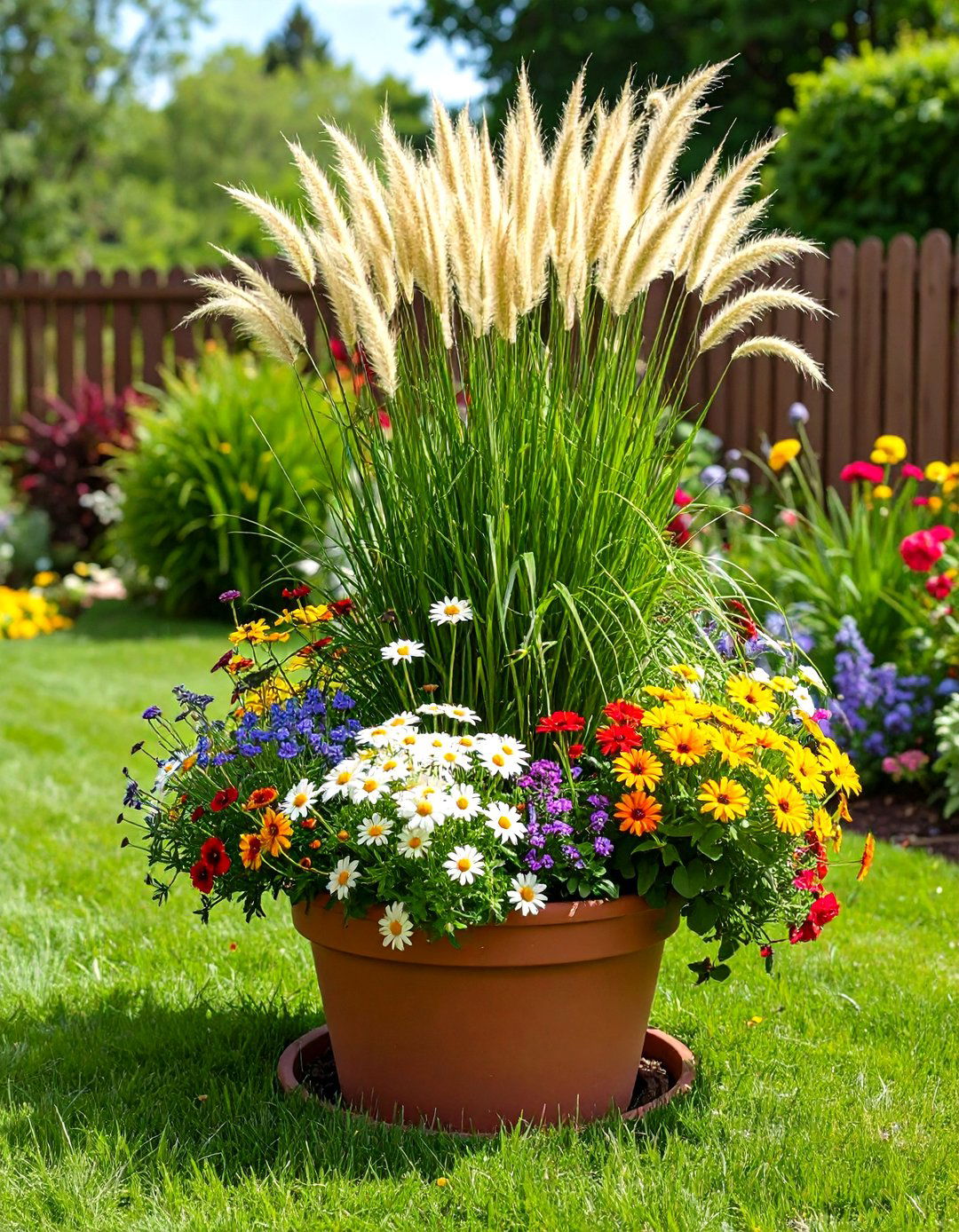
Incorporating ornamental grasses into a potted plant arrangement instantly adds vertical drama and graceful movement with every breeze. Select a tall grass like fountain grass or zebra grass as your thriller, then surround its base with millions of calibrachoa “Million Bells” for color and osteospermum daisies for crisp contrast. Grasses prefer well-draining soil and plenty of sun, so position your container accordingly and avoid overwatering. Trim brown or dead grass blades in early spring to rejuvenate new growth. The combination of feathery plumes with vibrant blooms gives your arrangement textural depth and seasonal flexibility—replace annual fillers as needed while the grass anchors the display year after year. This approach makes a striking focal point on any patio or porch.
8. Create Elegance with Roses and Begonias in Your Potted Plant Arrangement
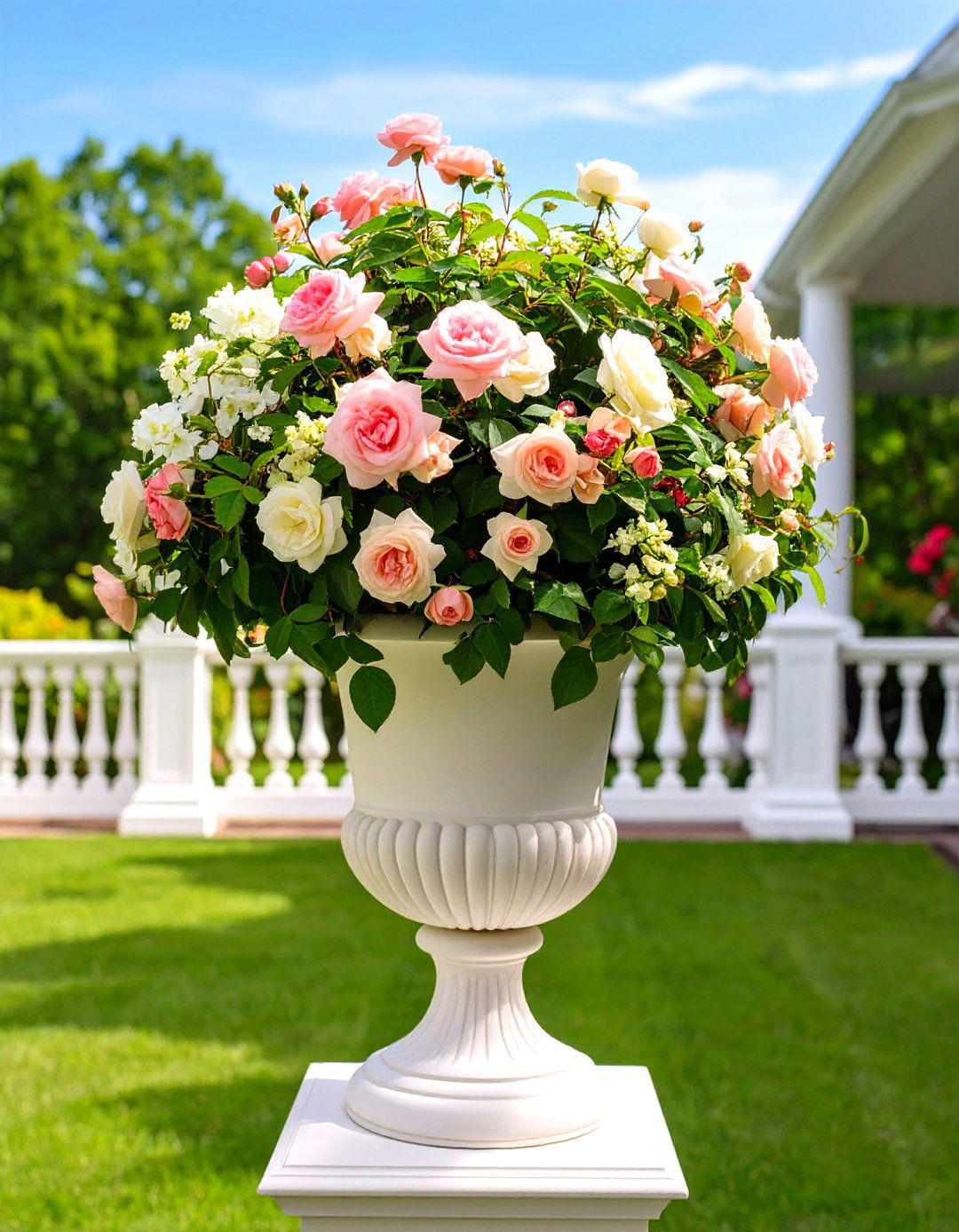
An elegant potted plant arrangement can be achieved by pairing the romantic blooms of a miniature tree rose with soft, petal-filled begonias and complementary vinca. Choose a tree rose variety such as ‘Baby Blanket’ to provide height and a focal point, then surround it with Prelude Pink begonias for lush, repeating blossoms. Complete the ensemble with white coconut cooler vinca for delicate trailing accents. Plant in a classic urn or pedestal pot filled with premium, well-draining soil. Deadhead spent rose petals and pinch back begonia stems to encourage bushier growth. Regular feeding with a balanced liquid fertilizer every three weeks will keep blooms prolific. This refined arrangement adds timeless charm to any patio setting.
9. Make a Cool-Season Stunner in Your Potted Plant Arrangement
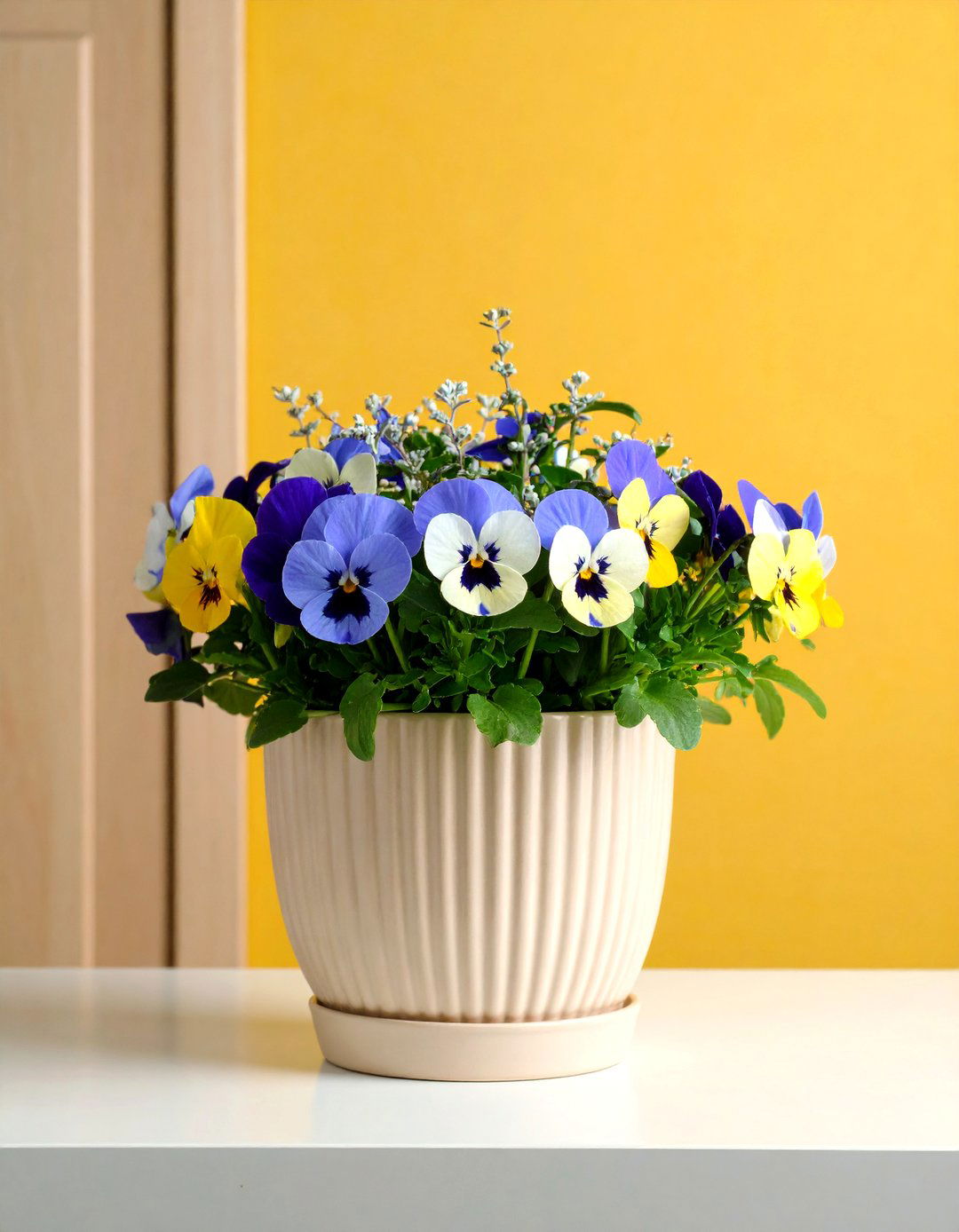
A cool-season potted plant arrangement shines in early spring and again in fall by embracing hardy blooms like pansies and fragrant licorice plant. Plant five violas pansies around the rim of a container, leaving space in the center for a clump of licorice plant whose silver foliage contrasts beautifully. Use a blue or white pot to enhance the cool palette and fill with a light potting mix that retains moisture without becoming soggy. Water consistently but avoid overwatering to prevent root rot. Once temperatures rise above 70°F (21°C), replace pansies with heat-tolerant annuals such as angelonia. With this strategy, your potted plant arrangement will transition seamlessly between cool and warm seasons.
10. Add Beauty to an Evergreen Base in Your Potted Plant Arrangement
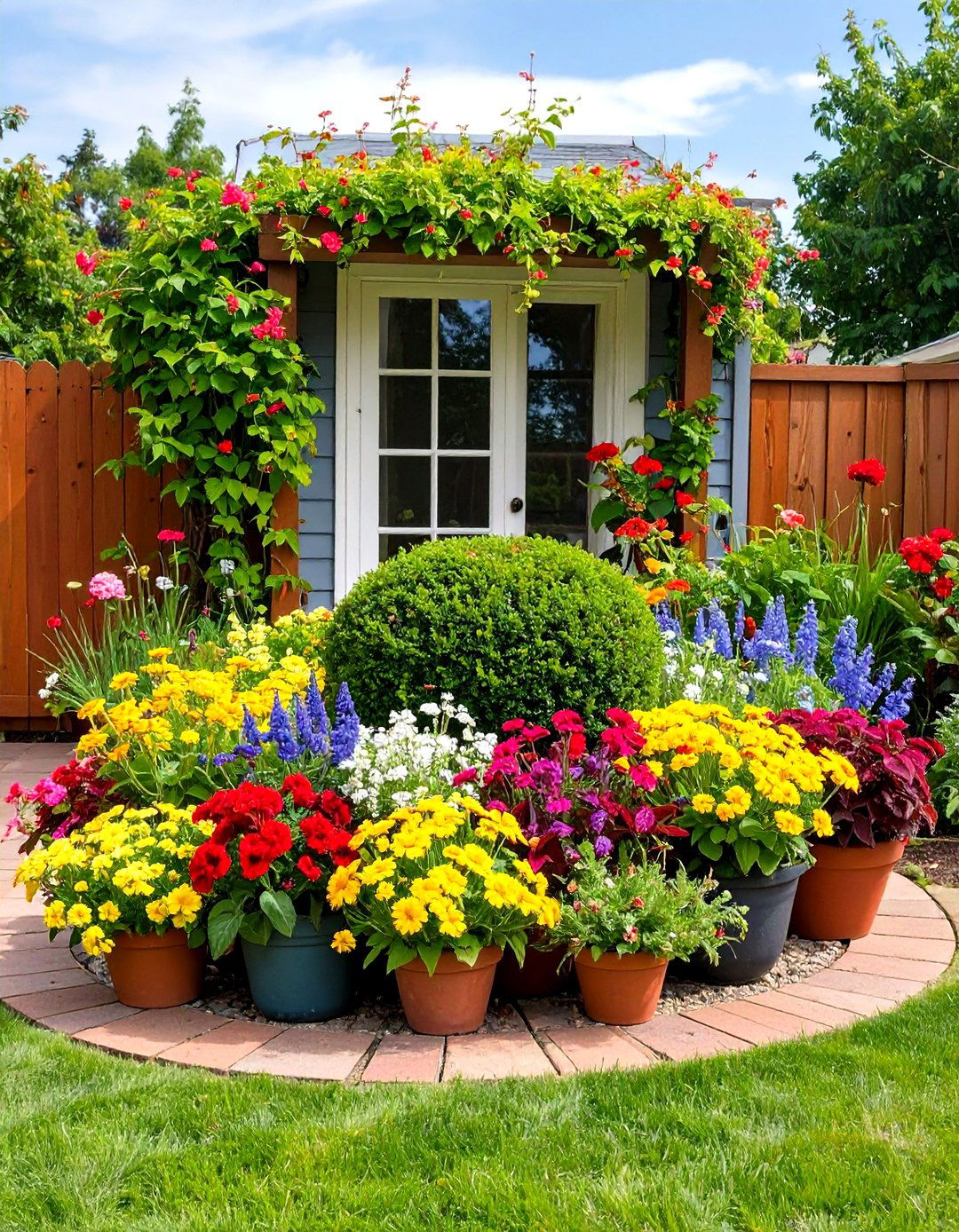
Starting a potted plant arrangement with an evergreen base like boxwood creates a year-round framework that you can refresh seasonally. In a sturdy container, plant a dwarf boxwood centerpiece to provide structure, then surround it with colorful verbena for low-maintenance blooms and coleus for bold foliage accents. Let hardy ivy trail over the edges for a softening spiller effect. Choose boxwood cultivars suited to your climate, and use a lightweight, well-draining potting mix to prevent waterlogging. Prune boxwood lightly each spring to maintain shape, and deadhead verbena regularly to encourage repeat flowering. This blend of evergreens and vibrant annuals produces a balanced potted plant arrangement that stays lively throughout spring and summer.
11. Infuse Festive Vibes into Your Potted Plant Arrangement with Patriotic Blooms
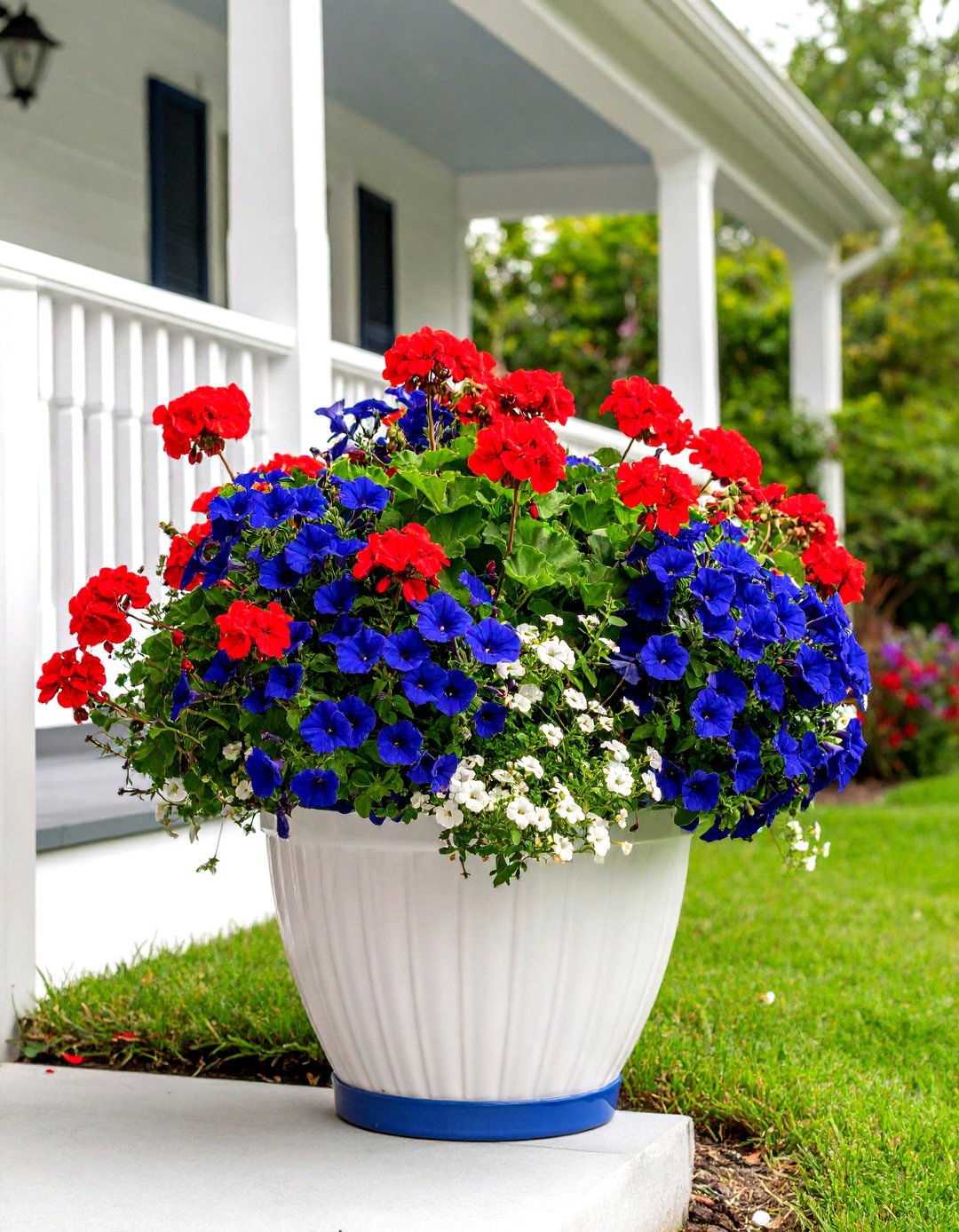
Transform any potted plant arrangement into a festive focal point by pairing red geraniums with cool blue Evolvulus “Blue Daze” in a crisp white or patriotic blue container. Plant a single geranium at the back as your thriller, then plant clusters of Blue Daze at the front to create a watery spill effect. Balance the color play by adding white alyssum or sweet potato vine as a softening spacer. Position this arrangement on a deck or near your entryway during national celebrations. Water consistently and fertilize lightly to maintain vibrant blooms through summer heat. This red, white, and blue composition will send a celebratory message in any outdoor living space.
12. Pay Attention to Texture in Your Potted Plant Arrangement with Grasses and Vines

Texture can be a game-changer in potted plant arrangements, providing visual contrast and tactile interest. Combine a fountain grass thriller with chunky coleus and delicate calibrachoa for a dynamic display. Start by placing the grass in the center or back of your chosen planter to establish vertical interest. Surround it with coleus in bold foliage hues, then tuck calibrachoa at the edges for a trailing spill effect. The interplay between the grass’s feathery blades, coleus’s lush leaves, and calibrachoa’s petite flowers creates an eye-catching tapestry. Use a lightweight, moisture-retentive potting mix and fertilize monthly. Regularly remove spent calibrachoa blooms and trim any leggy stems to maintain a polished plant arrangement.
13. Try Contrasting Textures in Your Potted Plant Arrangement Using Celosia and Foliage
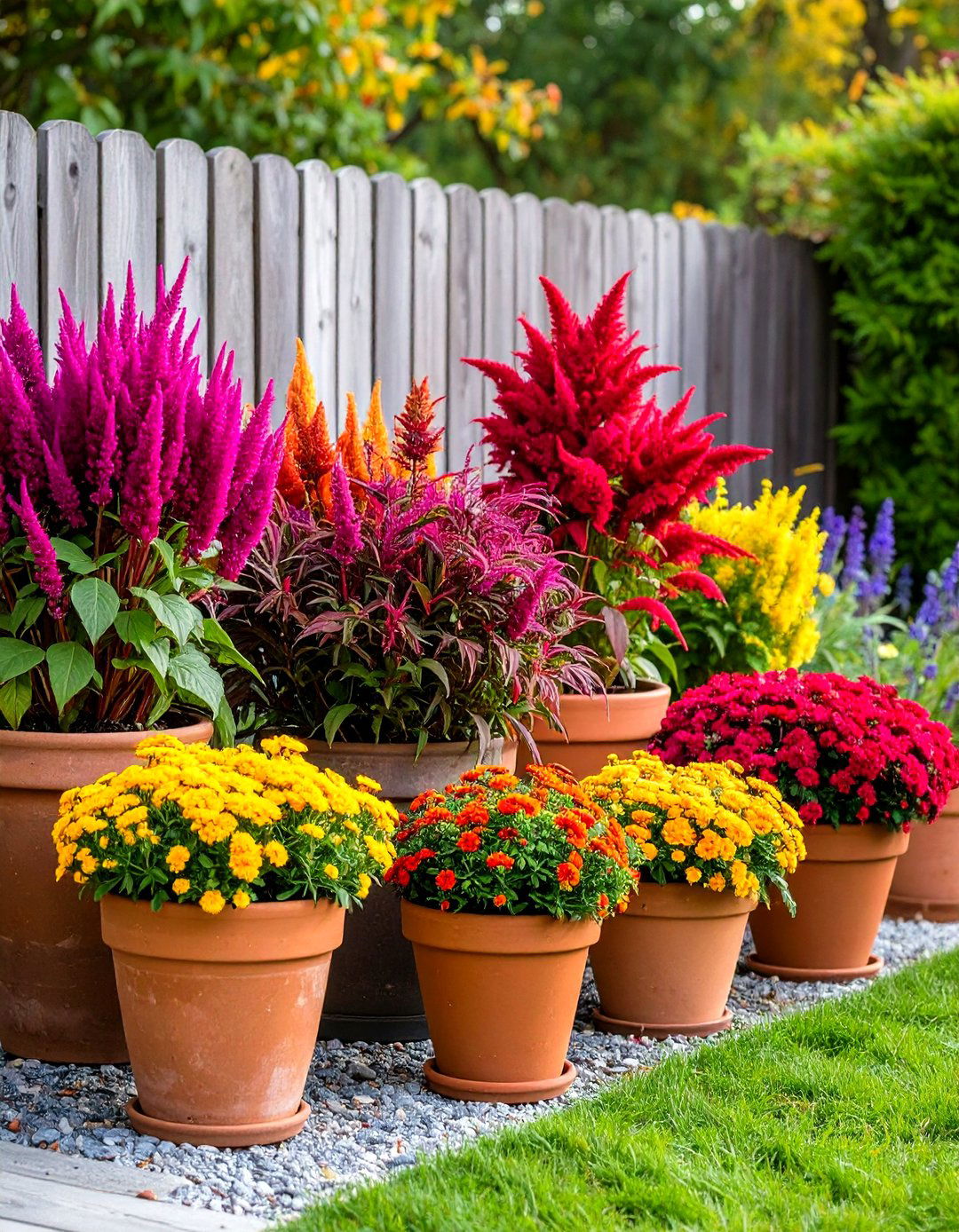
Contrasting textures bring depth and intrigue to a potted plant arrangement, especially when pairing spiky flowers with smooth foliage. Try featuring purple flamingo celosia as a vertical thriller alongside a cigarette plant Cuphea ‘Dynamite’ for its tubular blooms. Surround these with trailing calibrachoa and beefsteak Iresine for glossy leaves that highlight the floral shapes. Finally, tuck in a single decorative dahlia at the center for a burst of color and petal layers. Use a hearty potting mix and ensure your container drains well to keep roots healthy. Rotate the pot occasionally for even growth, and deadhead spent blooms to encourage continued flowering in this richly textured plant arrangement.
14. Add Layers of Interest to Your Potted Plant Arrangement with Grasses and Vines
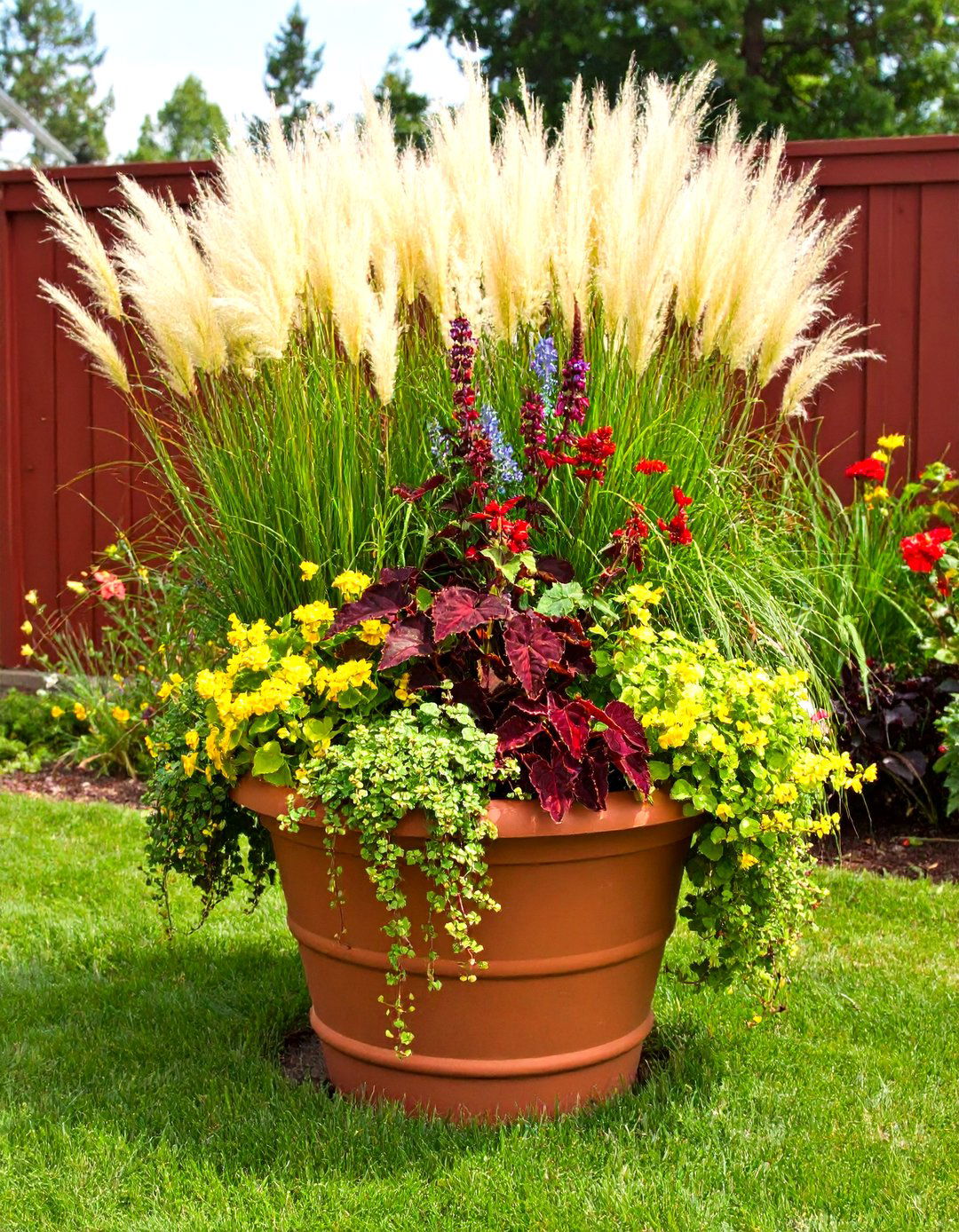
Layering different heights and forms creates an inviting potted plant arrangement with depth and dimension. Begin with a tall maiden grass thriller to set the vertical focal point, choosing a cultivar like ‘Morning Light.’ Next, plant wax begonias and bold coleus around it as mid-level fillers. Finally, let creeping Jenny trickle over the pot’s edge as a trailing spiller, softening hard lines and tying the layers together. Use a large terracotta container for stability, and fill it with moisture-retentive potting mix. Water deeply to encourage deep roots, then mulch the surface to conserve moisture. Regular pruning of spent blooms and foliage helps each layer maintain its distinct role within this layered plant arrangement.
15. Create Cottage Charm in Your Potted Plant Arrangement with Verbena and Plectranthus
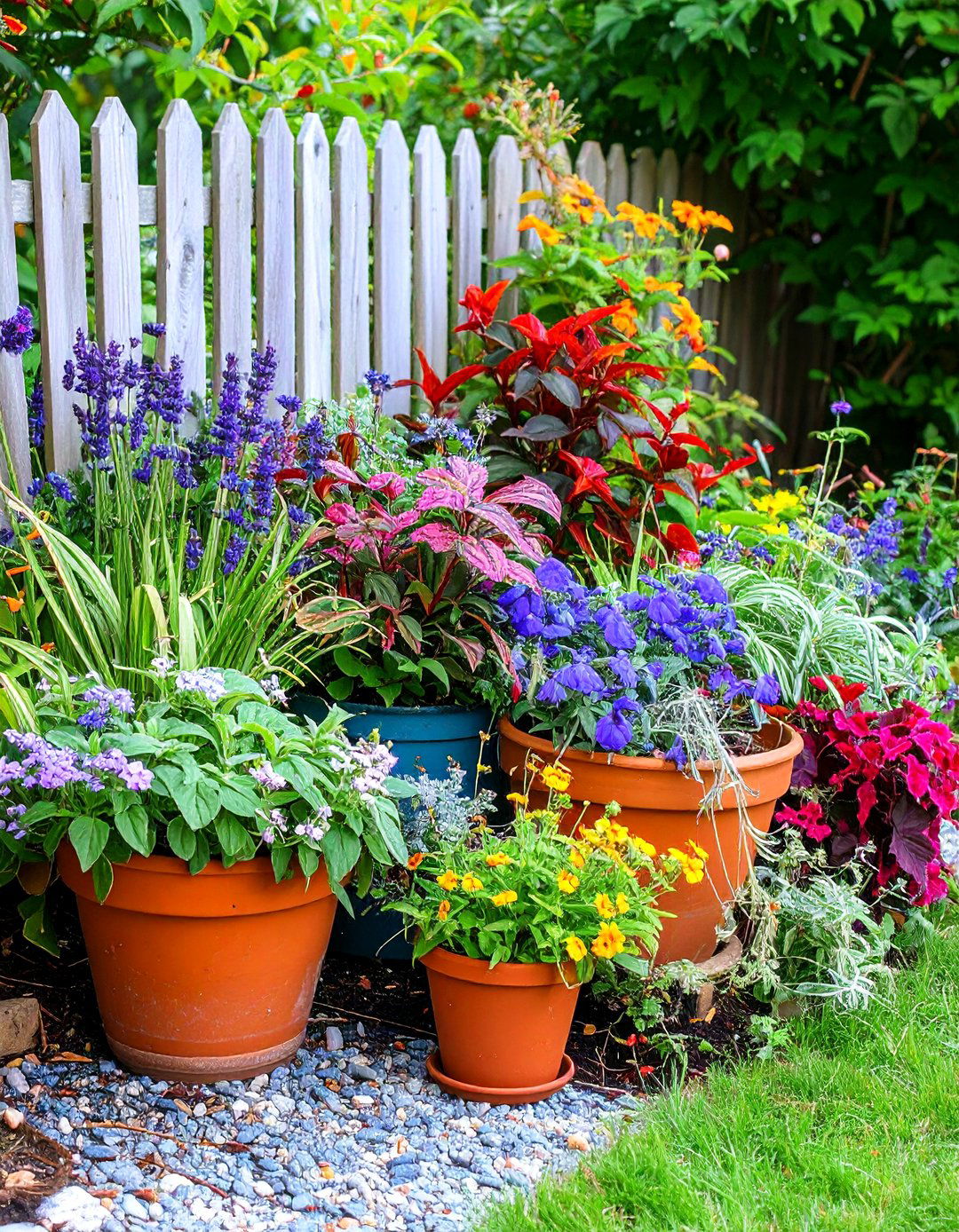
A cozy cottage-style potted plant arrangement embraces a relaxed, billowy design that feels natural yet curated. In a simple terra-cotta pot, cluster three bright verbena ‘Escapade Bright Eye’ at the back, pairing them with silver foliage plectranthus argentatus for contrast. Let parrot’s beak spill over the sides, creating a delicate curtain of coral blooms. This informal layout allows plants to fill space organically with minimal maintenance. Choose varieties known for resilience, and use a well-draining potting medium to avoid waterlogging. Lightly deadhead verbena to encourage continuous flowering, and trim parrot’s beak stems if they grow too long. This charming plant arrangement evokes an English garden in miniature.
16. Draw the Eye Up with Pineapple Sage in Your Potted Plant Arrangement

To guide the gaze skyward, include a tall pineapple sage spire in your potted plant arrangement. Position one or two sage plants at the back for height, brimming with bright red tubular blooms that attract hummingbirds. Fill the midsection with clusters of blue ageratum and white bacopa for a soft contrast, and edge the front with trailing Superbells calibrachoa in rose hues. Tuck in a few Swan River daisies and an Explorer Rose petunia for additional color accents and pattern variation. This layered approach balances height, fill, and spill, creating a cohesive vertical composition. Use a deep container and add a moisture-retentive potting mix. Deadhead regularly to sustain the display.
17. Maximize Color in Your Potted Plant Arrangement with Lantana and Gaura
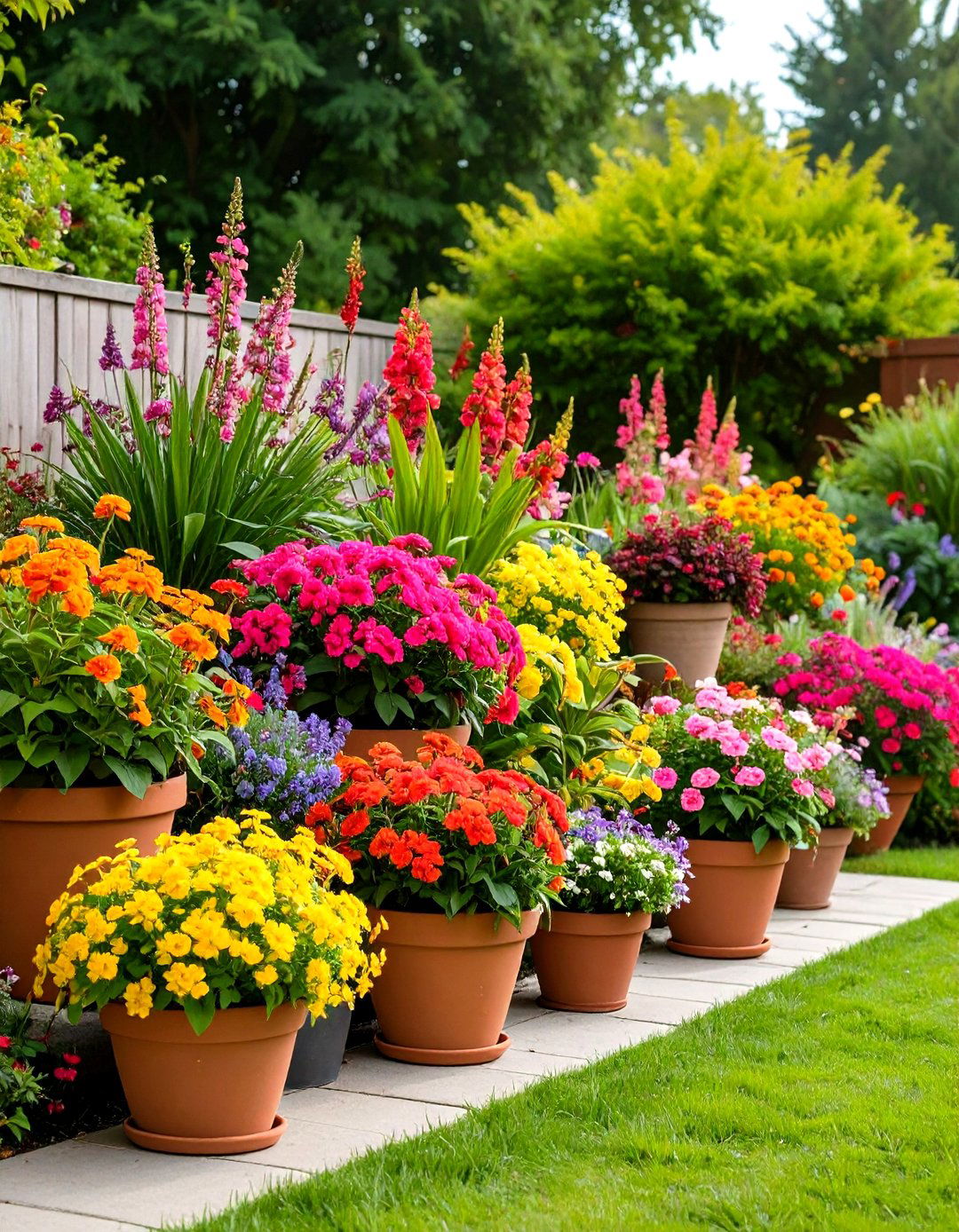
An explosion of color can be achieved by mixing showy bloomers like Lantana ‘Bandana Cherry Surprise’ with vibrant petunias and delicate gaura in your potted plant arrangement. Plant the lantana thriller at the center or back, then cluster petunia ‘Rose Double Madness’ around it for a saturated floral ring. Introduce a licorice plant with silvery foliage for visual rest and add gaura stems to contribute airy movement. This combination balances bold hues and soft shapes, resulting in a vivid tapestry of color. Select a neutral-toned container to let the blossoms shine and use a fertile potting soil enriched with slow-release fertilizer. Regular deadheading will keep the display full and lively.
18. Tuck It In: Small-Space Potted Plant Arrangements for Cozy Corners
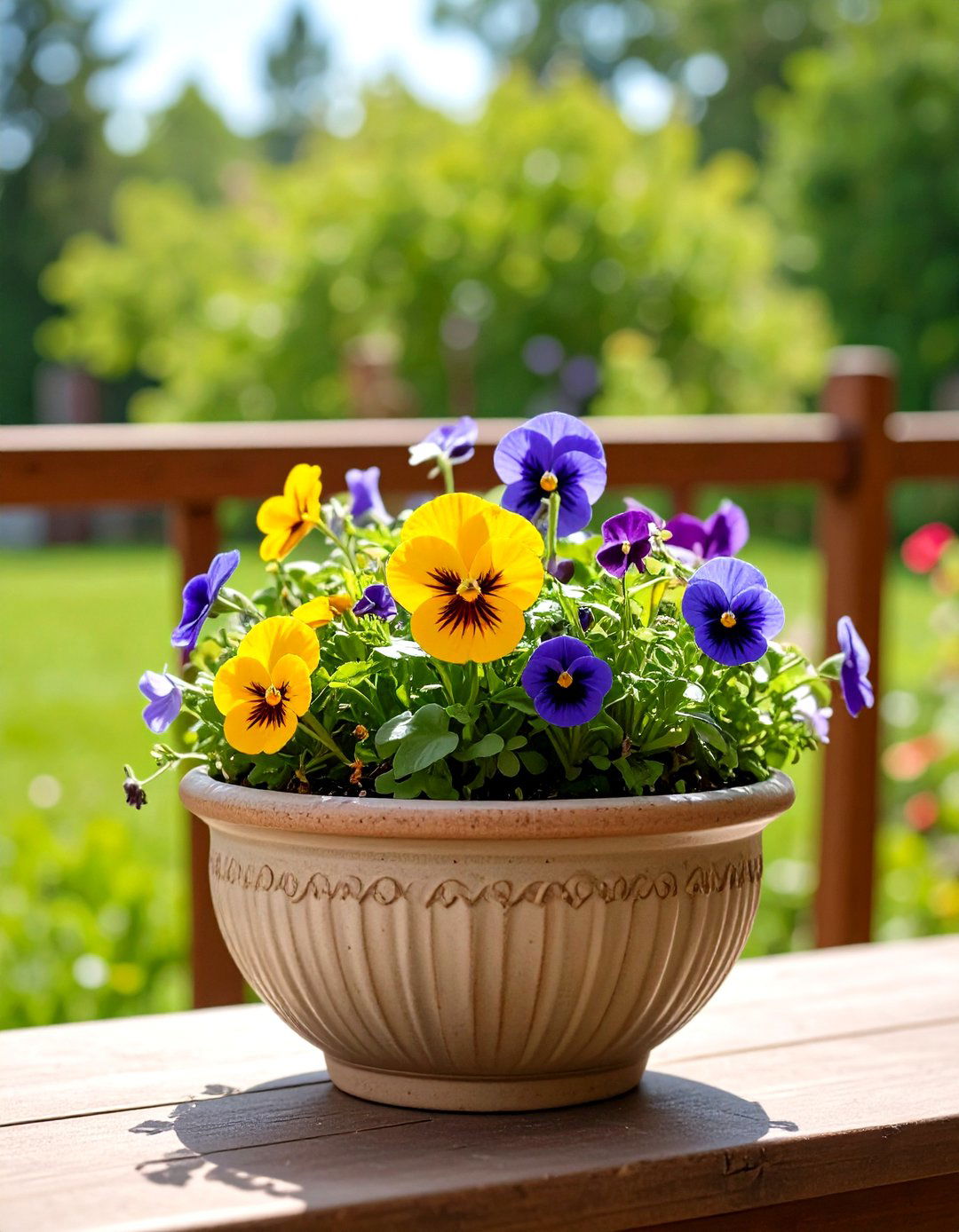
Small spaces can still host bold potted plant arrangements; a compact bowl or low planter works perfectly. Fill the base with a mix of colorful Nemesia varieties such as Sunsatia Pear, Raspberry, Lemon, and Cranberry, spacing them evenly. Add a single pansy in the center to anchor the composition. The close proximity of blooms creates a concentrated burst of color that reads as a unified display. Use a moisture-holding mix to minimize watering frequency in tight quarters, and choose a container with drainage holes to prevent soggy roots. Group multiple small pots in clusters for a fuller look. With strategic placement, even the tiniest balcony or windowsill becomes a charming greenery nook.
19. Enjoy Sweet Scents in Your Potted Plant Arrangement with Herbs and Alyssum
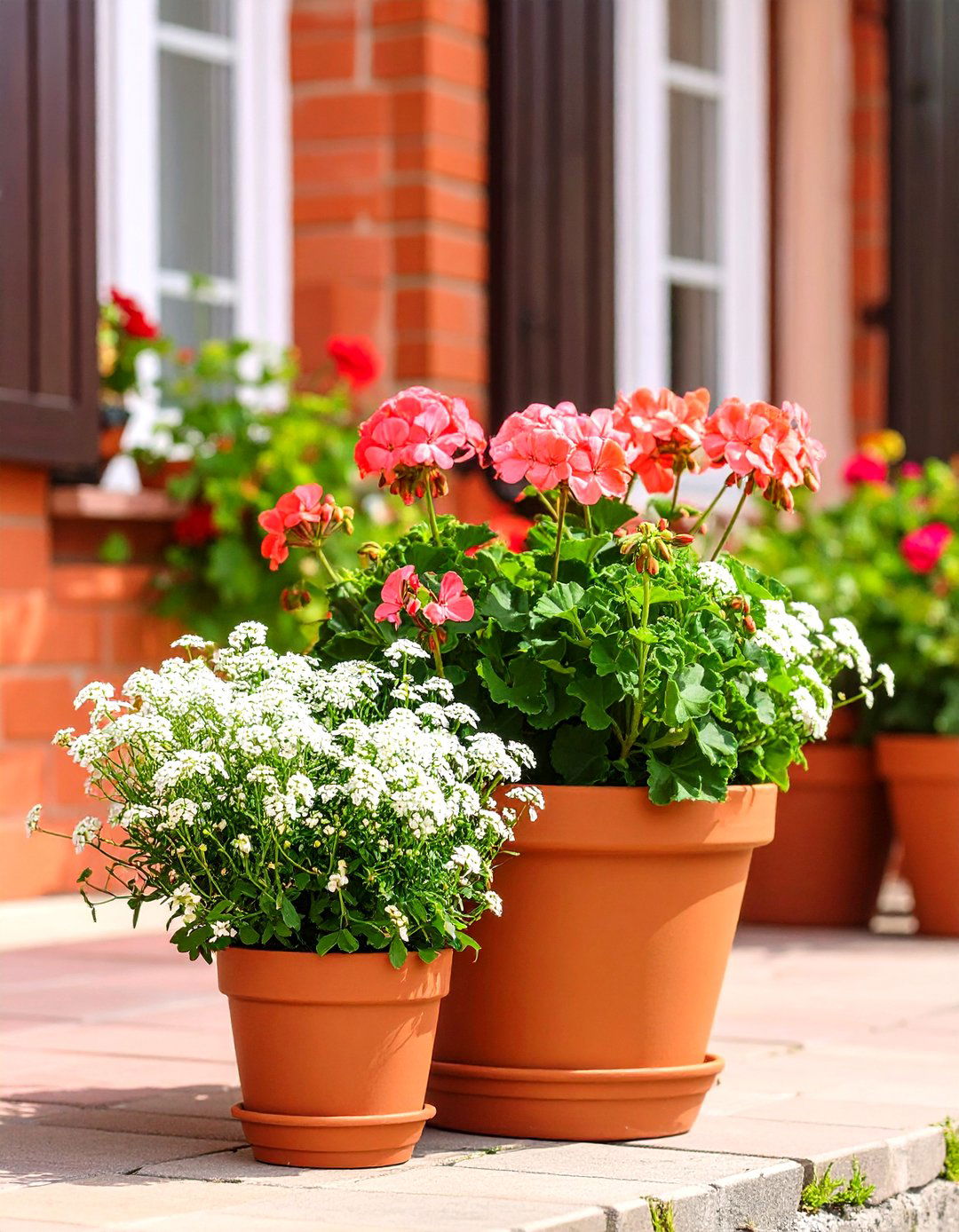
An aromatic potted plant arrangement can delight the senses when placed near seating areas or pathways. Start with a scented geranium like Pelargonium graveolens ‘Grey Lady Plymouth’ as the focal thriller at the back of the pot, then mass sweet alyssum around the front for a carpet of tiny, fragrant blossoms. The contrasting leaf textures and unified white and green color scheme create a peaceful, cottage-like vibe. Use a terracotta or clay container to moderate soil moisture, and apply a light, balanced fertilizer monthly. Water when the top inch of soil feels dry, and trim back any leggy stems to encourage bushy growth. This simple plant arrangement adds scent and softness to patios and entryways.
20. Be Romantic: Pink-Focused Potted Plant Arrangements for Soft Ambiance

Soft pink tones can create a romantic potted plant arrangement that feels both delicate and inviting. In a pastel-hued container, plant clusters of salmon-red Godetia to fill the pot, adding bright verbena ‘Babylon Purple’ for unexpected contrast. Tuck in tall snapdragons in shades of bubblegum to draw the eye upward, then let the scene soften with trailing pink calibrachoa or creeping phlox if space allows. Choose a container with a subtle decorative pattern to enhance the gentle palette. Keep soil consistently moist and feed with a bloom-boosting fertilizer every three weeks. Prune any faded blooms to keep the arrangement looking fresh and dreamy. This plant arrangement brings a whisper of romance to porches and patios alike.
Conclusion:
Exploring these potted plant arrangement ideas reveals how thoughtful combinations of foliage, blooms, color, texture, and container choice can transform any space into a vibrant sanctuary. Whether you lean toward foliage-forward designs, striking color schemes, or a romantic pink bouquet, understanding basic thriller, filler, and spiller principles empowers you to craft your own unique plant arrangements. By experimenting with various plant pairings and container styles, you’ll discover which arrangements flourish in your environment and personal style. Embrace these concepts to elevate balconies, patios, or windowsills with living artistry, and let each potted plant arrangement reflect your creativity and the beauty of nature.




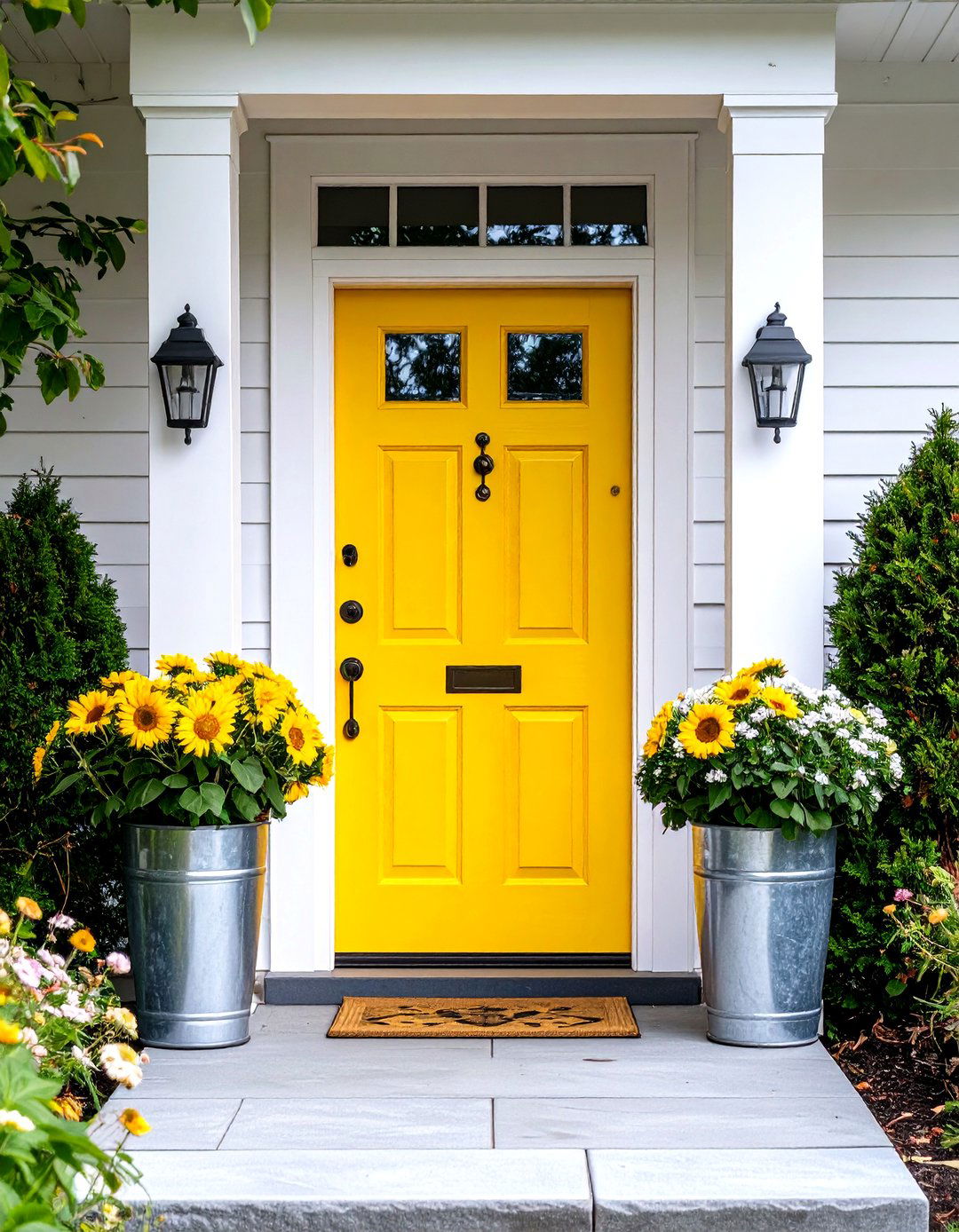
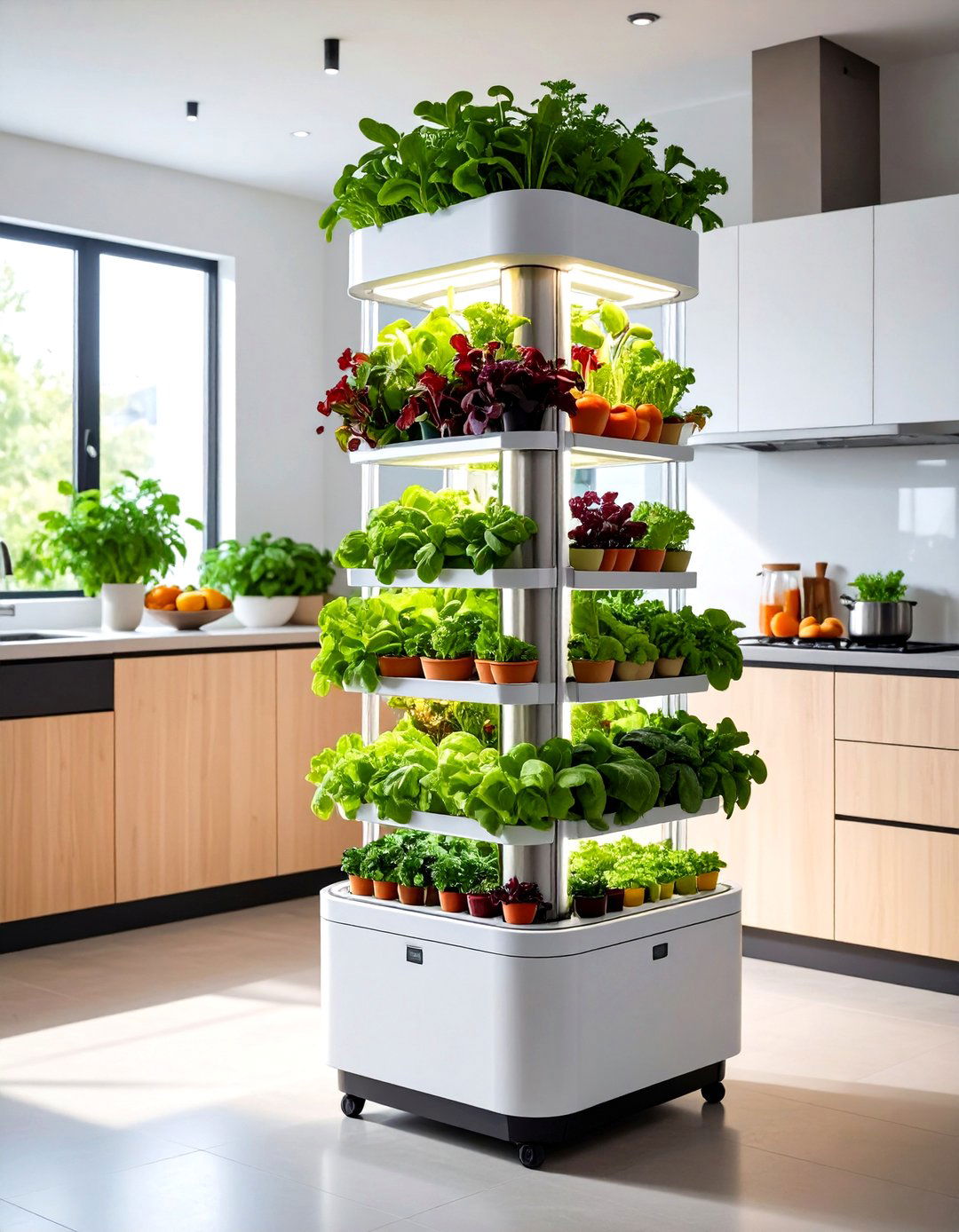

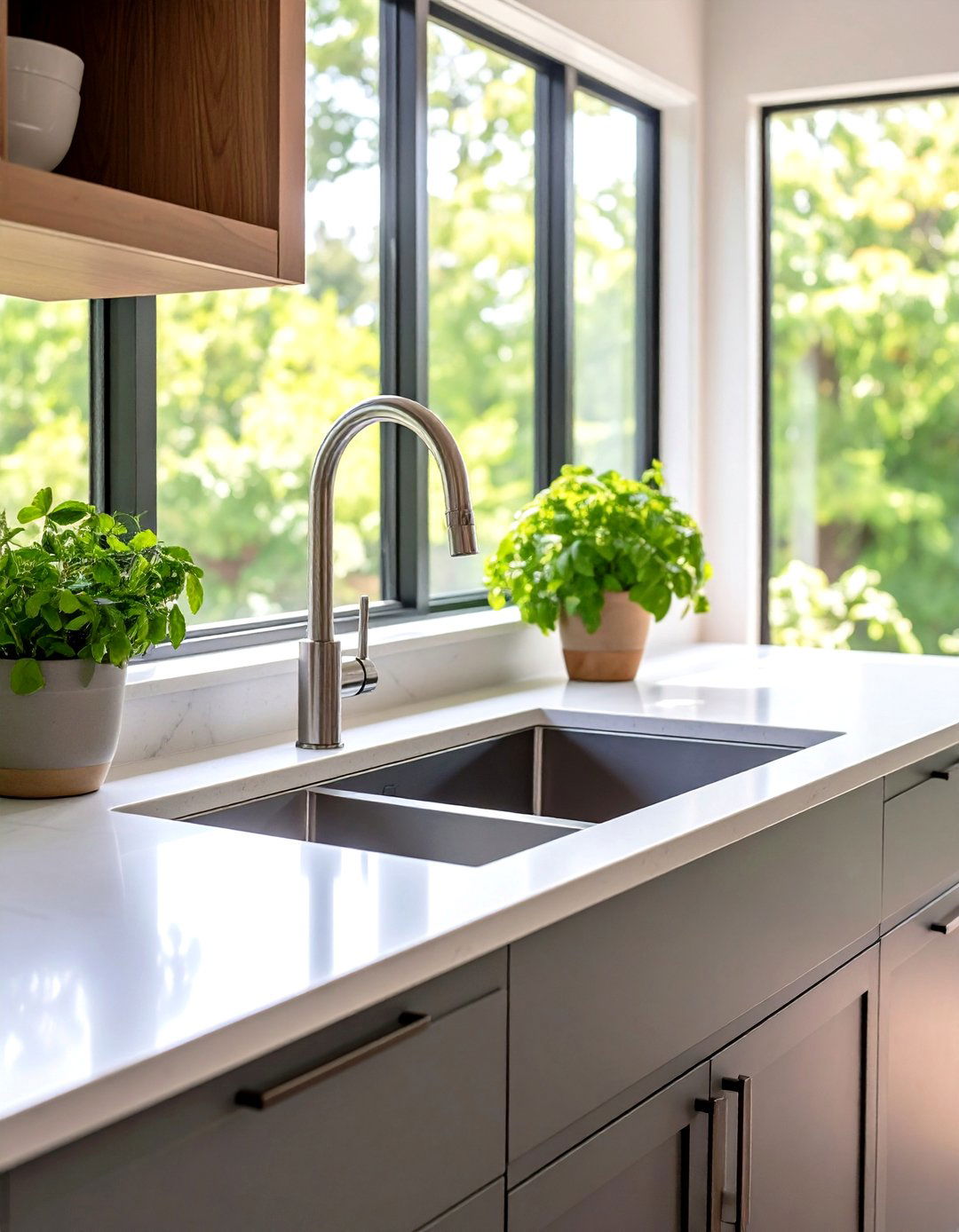
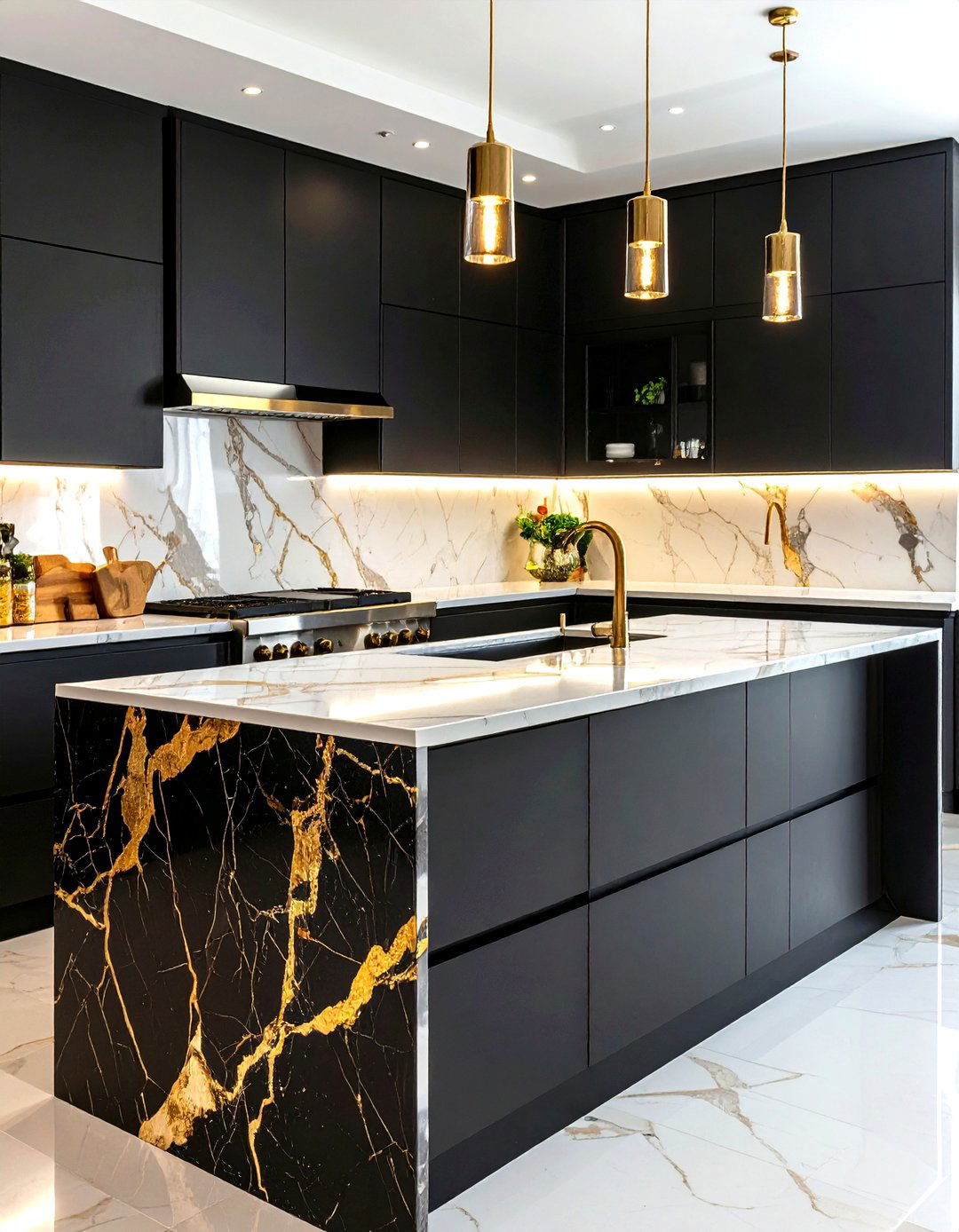
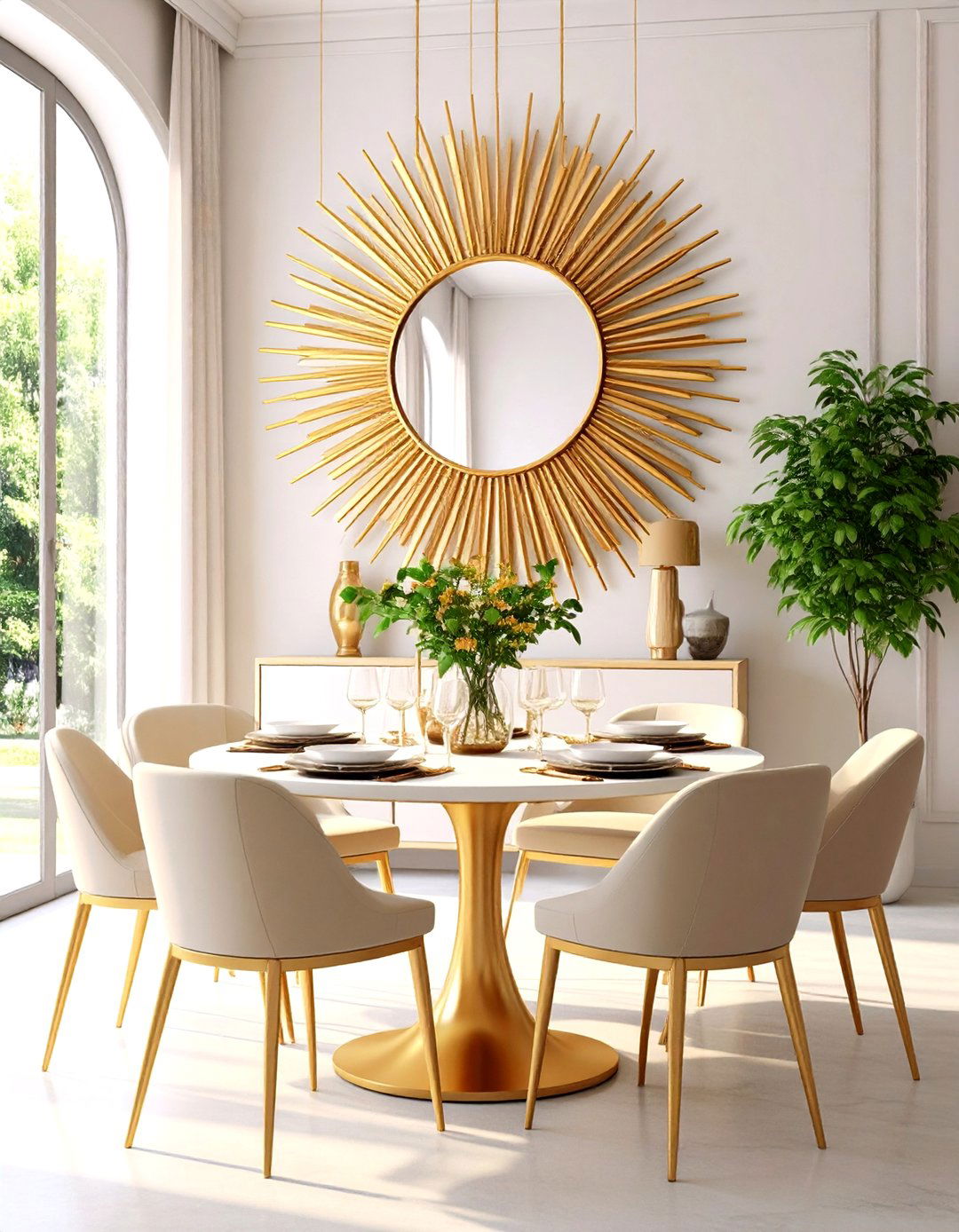


Leave a Reply